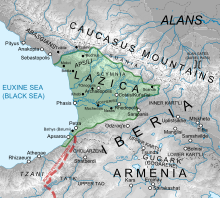Mihr-Mihroe
Mihr-Mihroe | |
|---|---|
| Born | Unknown Sasanian army |
| Battles/wars | Iberian War
|
Mihr-Mihroe (died 555),
Biography
Nothing is known of his early life, but Mihr-Mihroe is recorded as an old man by 555. He first appears in summer 530, during the

In 542, after the renewal of hostilities in 540, Mihr-Mihroe was dispatched by
Phabrizus was attacked in the next year by the Lazi and the Byzantines, but the Persians somehow managed to resupply Petra. The new Byzantine commander,
In 554 news spread about him being critically ill. However, he launched an attack and
He was old, lame, and unable to ride, but brave, experienced, and "energetic as a youth".[13]
A brilliant organiser and an excellent tactician, he was above all a man of intrepid spirit. When he was already an old man and had long been crippled in both his feet so badly that he was unable even to ride a horse he displayed the stamina and endurance of a young man in his prime. Nor did he fail to take part in the actual fighting, but borne on a litter he would move about the ranks of battle, exhorting and encouraging his men and issuing timely and accurate instructions he struck terror into the hearts of the enemy and reaped the fruits of many a victory. Never indeed was there a more striking illustration of the fact that brains and not brawn are the prerequisite of a good general.
— Agathias, [14]
After his death, Nachoragan succeeded him in his command.[15]
References
- ^ Henry Fynes Clinton (1853). An Epitome of the Civil and Literary Chronology of Rome and Constantinople: From the Death of Augustus to the Death of Heraclius. University Press. pp. 235–.
- Encyclopaedia Iranica, edited by Ehsan Yar-Shater, Routledge & Kegan Paul Volume 6, Parts 1-3, page 281a
- ^ Rezakhani & Nicholson 2018.
- ^ a b c d e f Martindale, Jones & Morris 1992, p. 884.
- ^ Greatrex & Lieu 2002, p. 91.
- ^ Greatrex & Lieu 2002, pp. 94–95.
- ^ Greatrex & Lieu 2002, pp. 111–112.
- ^ Greatrex & Lieu 2002, p. 117.
- ^ Greatrex & Lieu 2002, p. 119.
- ^ Greatrex & Lieu 2002, p. 120.
- ^ Martindale, Jones & Morris 1992, pp. 884–885; Greatrex & Lieu 2002, p. 91.
- ISBN 9789004108448.
- ISBN 9780486143392.
- ISBN 978-3-11-082694-4.
- ^ Tyler, Moses Coit (1897). Mediæval history. R. S. Peale, J. A. Hill. p. 1309a.
Sources
- Greatrex, Geoffrey; Lieu, Samuel N. C. (2002). The Roman Eastern Frontier and the Persian Wars (Part II, 363–630 AD). New York, New York and London, United Kingdom: Routledge (Taylor & Francis). ISBN 0-415-14687-9.
- Martindale, John Robert; Jones, Arnold Hugh Martin; Morris, J., eds. (1992). The Prosopography of the Later Roman Empire, Volume III: A.D. 527–641. Cambridge, United Kingdom: Cambridge University Press. ISBN 978-0-521-20160-5.
- Rezakhani, Khodādād; Nicholson, Oliver (2018). "Mihr-Mihroe". In Nicholson, Oliver (ed.). The Oxford Dictionary of Late Antiquity. Oxford University Press. ISBN 9780198662778.
